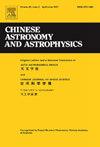利用立体观测减小太阳磁场测量误差
Q4 Physics and Astronomy
引用次数: 0
摘要
从单点观测太阳磁场,可以测量沿视线方向的磁场分量和垂直于视线方向的磁场分量(横场)。但是,横向磁场的精度比径向磁场低一个数量级,而且横向磁场的方向有180°的不确定性。本文的目标是提高太阳磁场横向场的精度。考虑在日地L5点和地球同时观测磁场,通过模型构建和数据分析来减小误差。具体方法如下:利用球面三角公式求得地球与L5点磁场的坐标关系,利用误差传播公式求得L1点横向磁场的修正误差。然后,我们计算了太阳磁场数据的误差分布,并模拟了两个符合太阳磁场分布的数据,分别作为地球和L5点的误差图。最后,结合地球和L5点的数据,得到了减小了地球横向场误差的校正数据,并与原始横向场数据进行了比较。结果表明,地球的横向场误差可以减小到原来的17%左右。本文章由计算机程序翻译,如有差异,请以英文原文为准。
Reducing the Measuring Error of Solar Magnetic Field by Stereo Observation
Observing the solar magnetic field from a single point, we can measure the magnetic field component along the line of sight and the magnetic field component perpendicular to the line of sight (transverse field). However, the accuracy of transverse field is one order of magnitude lower than that of the radial field, and there is a uncertainty in the direction of the transverse magnetic field. The goal of this paper is to improve the accuracy of the transverse field of the solar magnetic field. It is considered to observe the magnetic field at the Sun-Earth L5 point and Earth simultaneously, and the error reduction can be obtained through model construction and data analysis. The specific methods are as follows. Coordinate relations of magnetic fields at Earth and L5 point are obtained by spherical trigonometry formula, and the corrected errors of the transverse magnetic field at L1 points are obtained by error propagation formula. Then, we calculate the error distribution of the solar magnetic field data, and simulate two data conforming to the solar magnetic field distribution, which are respectively used as the error diagram of Earth and L5 point. Finally, by combining the data of Earth and L5 point, the corrected data whose transverse field error at Earth has been reduced, are obtained and compared with the original transverse field data. It is found that the transverse field error of Earth can be reduced to about 17% of the original.
求助全文
通过发布文献求助,成功后即可免费获取论文全文。
去求助
来源期刊

Chinese Astronomy and Astrophysics
Physics and Astronomy-Astronomy and Astrophysics
CiteScore
0.70
自引率
0.00%
发文量
20
期刊介绍:
The vigorous growth of astronomical and astrophysical science in China led to an increase in papers on astrophysics which Acta Astronomica Sinica could no longer absorb. Translations of papers from two new journals the Chinese Journal of Space Science and Acta Astrophysica Sinica are added to the translation of Acta Astronomica Sinica to form the new journal Chinese Astronomy and Astrophysics. Chinese Astronomy and Astrophysics brings English translations of notable articles to astronomers and astrophysicists outside China.
 求助内容:
求助内容: 应助结果提醒方式:
应助结果提醒方式:


